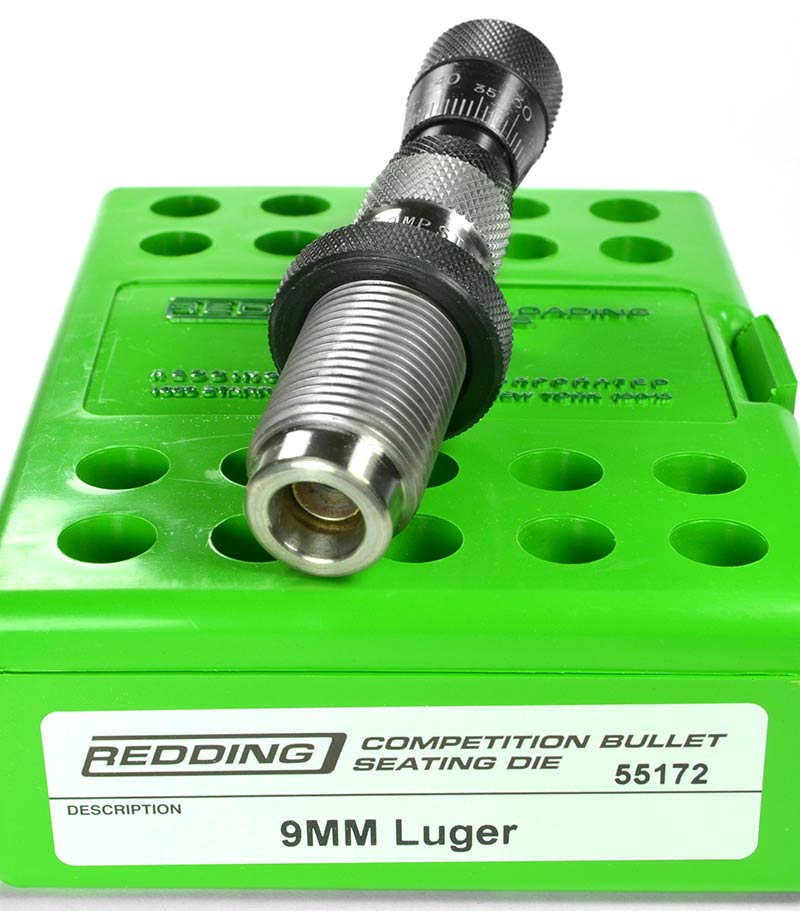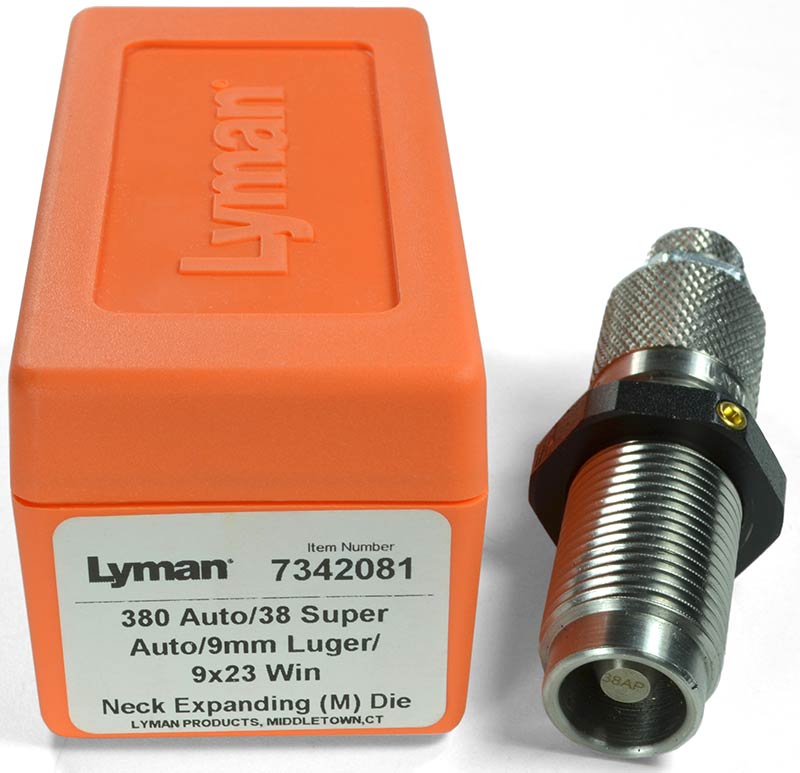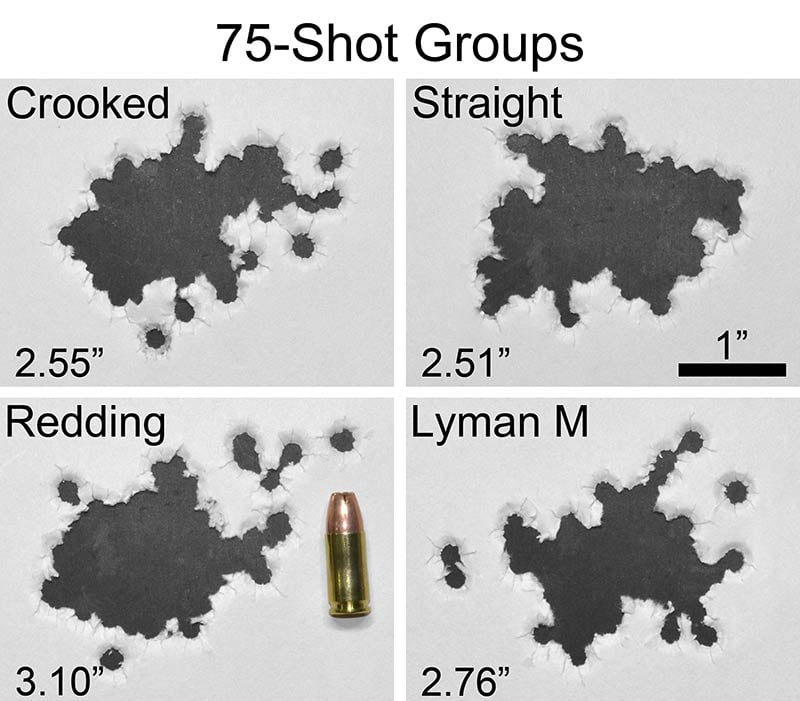Crooked-Seated Bullets and Accuracy
Does It Really Matter At Handgun Distances?
How important is it to seat the bullet perfectly strait in the case? What if the bullet is seated crooked? Does this affect accuracy? Common sense says it would. After all, if it starts out crooked, it might remain crooked and be skewed a little when it exits the barrel, or it could distort the shape of the bullet as it enters the bore and upset its center of gravity. If the base is crooked, there will be a slight difference from one side to the other when the gas exits the barrel as the bullet exits the bore. This asymmetrical gas release could cause the bullet to yaw and affect its flight path. Bullets with different flight paths won’t hit the same spot. Makes sense? Right? Well, does it?
Let’s see.
Norman E. Johnson’s 1972 article (footnote 1), “Bullet Alignment vs. Accuracy” demonstrated bullet alignment (runout) has a measurable effect on rifle accuracy. Daniel Lilja (footnote 2) writes with respect to chamber throat and bore concentricity, and explains the mechanism behind the loss of accuracy a little clearer, “The bullet must get started into the rifling straight. If it doesn’t; it will become somewhat deformed and will not be centered in the barrel. Upon exiting the muzzle it becomes free to rotate around its new center-of-gravity, departing from the centerline of the barrel. In effect it will make a corkscrew-type path around the barrel centerline.”
Crooked bullets are not pointed, or aligned, directly down the middle of the bore. Thus the bullets could undergo some deformation when entering the bore, changing their center of gravity and flight path.
Being the mad scientist I am, I was curious just how much crooked bullets would enlarge group size in a handgun. I imagined there would be fliers of some sort and obviously enlarged groups. So I loaded 9mm ammo with purposefully crooked bullets. This was, perhaps unfortunately, easily accomplished.
The photo shows how I placed the bullet on the case. When this is pushed into the seating die, the bullet mostly straightens out, but not completely. The cutout of the flat nosed seating stem of my Dillon die is wider than the tip of the hollow point bullet. This allows the bullet to remain slightly crooked as it’s pushed into the case. When fully seated, the bottom of the bullet produces a bulge in one side of the case while the other side has no bulge at all. And the bullets look crooked to the naked eye. Straight seated bullets, on the other hand, have a small bulge around the entire circumference of the case.
First Tests
For my initial test I loaded 125-grain Hornady HAP bullets at 1.090″ overall length with 5.7 grains of Power Pistol. I loaded another batch with straight seated bullets and fired 20-shot groups at 25 yards from a Ransom Rest. The gun was a Para Ordnance frame with a Caspian Slide and Rock Island Armory barrel.
The straight seated bullets produced a 2.2″ group. The crooked seated bullets produced a 1.9″ group. Wait. What? Yup, the crooked bullets produced a smaller group than the straight bullets. I fired other groups containing a mixture of straight and crooked bullets, but the smallest group was with all the bullets seated crooked.
That wasn’t supposed to happen.
Like a good mad scientist, I repeated the experiment, this time with a Glock G19 in the Ransom Rest, and shooting two 15-shot groups with each type of ammo. Same result. The crooked bullets produced smaller groups, on average, than the straight bullets.
I was persistent and repeated the test again in the Glock. This time the crooked bullets produced larger groups than the straight bullets. Of course, this only means half the tests in the Glock showed the crooked bullets shooting better, and half the tests show them shooting worse. You’d expect a 50/50 split just by chance if there was no practical difference in accuracy between crooked and strait seated bullets.
These are the kind of results that drive scientists mad. The results are supposed to turn out the way you expect them to. It was clear something was amiss. Maybe it was the assumption crooked bullets produce larger groups. Maybe there was something about the ammo.
It was easy to seat bullets crooked. It was not so easy to seat bullets straight, and many attempts to seat bullets straight produced obviously crooked bullets. In fact, a lot of the straight seated rounds were rejected because they were obviously crooked. If the bullet was even slightly crooked when placed in the case mouth, it was pushed in at that angle. The angle of the straight seated bullets was probably more variable than the crooked seated bullets, though that was hard to say for certain.
I needed a better way to seat the bullets straight, because my method was more hit-or-miss than reproducible. No problem. There are special dies made just for that purpose.
Straight Is As Straight Does
Lyman makes a neck expanding die called the M die. It expands the inside of the case neck to allow you to manually insert the bullet into the case a little before it’s pushed in the rest of the way with the seating die. It expands the brass 1/16″ deep, according to Lyman, from the case mouth. This can also help cast bullets prevent shaving lead, or coating, during seating.
The M die does help with the initial bullet alignment. When I placed a bullet in the case it was nicely oriented straight. Well, there is a little room to wiggle the bullet, and although it isn’t much, you still have to pay attention to the bullet’s orientation to make sure it looks straight.
If I placed the bullet in the case as crooked as the sizing would allow, it was pushed in crooked. Once again it appeared if the bullet is even slightly askew when placed in the case, it would be pushed in at that angle, so it’s important to orient the bullet as straight as possible before seating, even when using the Lyman M die.
Hornady and Redding make dies for pistols aligning both the case and the bullet during the seating step. Hornady’s in-line bullet seating system aligns the bullet, case neck and seating stem. Redding’s Competition Seating Die completely supports the cartridge case during alignment. I decided to go with the Redding Competition Seating Die. They claim, “This Patented System assures you of the best possible bullet alignment.” I’m holding them to that!
The Redding Competition die does a good job of aligning the bullet and case, even if the bullet is placed crooked. When I tried this, the loaded rounds had a bulge around the entire circumference of the case, suggesting it did a better job of correcting bullet angle than the Lyman M die.
I tried a combination of the Lyman M die and the Redding Competition seating die, and tested it by setting the bullet in the case at as crooked an angle as the M die sizing would allow. The question was whether the Redding Competition die would straighten out the bullet. The answer is, mostly, but not completely. While seating with the Redding die did result in a bulge around the entire circumference of the case, it was slightly asymmetrical. Thus combining these two dies did not magically produce perfectly straight seated bullets. You still have to do your part when using the M die and place them as straight as possible.

The hand-placed bullet is in a flared case. Note the bullet in the flared case is a little crooked.
It is very difficult to get bullets aligned perfectly straight when placing them by hand in regular
flared brass. The M die hand-placed bullet is pushed by hand into the depth of the expanded
neck created by the die. The M die can also flare the case mouth, but was not done for this example.
More Shooting
The final accuracy test consisted of four categories of ammunition. 1) Purposefully crooked. 2) Straight — placed by hand. 3) Cases sized with the Lyman M die and seated with the Dillon seating die. 4) Bullets seated with the Redding Competition seating die.
I considered excluding imperfectly loaded rounds from the “Straight — placed by hand” group, but decided to include them. Why? Because that’s what we normally do with our ammo. We align the bullet, we seat it, crimp it and it goes in the ammo box. Done. Thus, we end up with a mixture of rounds with some seated straight and some not. That’s reality.
The test gun was a Para Ordnance high capacity frame with a Caspian slide and a Kart 9mm barrel. The Kart barrel fits well in the front and rear of the slide and on the slide stop. There is some horizontal play in the slide-to-frame fit, but little vertical play.
For this test I loaded 115-grain Zero JHP bullets at 1.115″ overall length in new Starline brass with 6.5 grains of Power Pistol and CCI 500 primers. I loaded 75 rounds for each category of ammunition to be tested. With four categories, that totaled 300 rounds.
The gun was placed in the Ransom Rest and rounds fired for sighting in and settling shots, the barrel was removed and cleaned with Hoppe’s Elite gun cleaner and 10 strokes with a bronze brush followed by cotton patches. The barrel was reinstalled and 10 rounds of “fouling” ammo (same bullets and powder) were fired to prep the barrel. Then I fired five consecutive 15-shot groups at 25 yards with one category of ammunition (for example, all crooked), for a total of 75 rounds.
After the 75 rounds were fired, the barrel was removed and cleaned again as described above, and another ten rounds of fouling ammunition was fired prior to the start of the next 75 round series. This sequence was repeated for each remaining category of ammunition.
In addition to individual 15-shot targets, a “master” target was first placed behind the 15-shot target. The master target was used to record the full spread of all 75 rounds of that category of ammunition.
Results
My beautiful hypothesis that crooked seated bullets would produce fliers and enlarged groups was shot dead.
The 75-shot groups are most telling, since they show the overall spread of all the rounds fired for a given category of ammunition. The crooked bullets were some of the most consistently accurate, and their 75-shot group measured 2.55″, second only to the straight bullets placed by hand which produced a 75-shot 2.51″ group. The difference in group size is a mere 0.04″. In addition, the crooked bullets produced the smallest average 15-shot group size of 2.00″.
Surprisingly, the ammunition loaded with the dies that do the best job at aligning the bullet produced the largest groups. The largest 75-shot group was 3.10″ and was the ammunition loaded with the Redding Competition die. That’s 0.55″ larger than the crooked bullets. It’s not much bigger, but it is bigger. The ammunition loaded with the Lyman M Die produced an intermediate 75-shot group size of 2.76″.
The smallest 15-shot group was 1.07″ produced by the Redding Competition die ammo, but this is clearly a statistical anomaly. The Redding die ammo also produced the largest 15-shot group at 3.02″.
I certainly did not expect these results. I expected the Lyman and Redding dies to produce tighter groups than the hand placed or crooked bullets. Instead, they produced the largest 75-shot groups. Life is full of surprises.
One could argue this comparison is, itself, a statistical anomaly and I might find different results if I repeated it a few times. Perhaps, but the previous data with the Rock Island Armory barrel and Glock didn’t show the crooked seated bullets were obviously less accurate.
There were 75 chances for the crooked seated bullets to produce fliers. They didn’t, and the other categories of ammunition each had 75 chances to prove they were more consistently accurate. That didn’t happen either.
I’m not saying bullet alignment does not affect accuracy. I’m sure it does. That said, it did not make a difference with this ammunition in this gun at this distance. If alignment had a chronic negative affect on accuracy, one would expect it to show up with some regularity. The fact crooked bullets were as accurate (or more accurate) than aligned bullets in this test, suggests alignment isn’t that important in every circumstance.
Just This Particular Set Of Circumstances
I also don’t want readers to think crooked seated bullets are more accurate than straight seated bullets even though the crooked bullets produced smaller groups than those loaded with the Redding Competition and Lyman M dies. The 75-shots are just samples of how the gun shoots with this load, and there will always be some variation between group sizes from one 75-shot group to another even when all the ammo is loaded by the same method. But since the crooked bullets group was smaller than the Redding or Lyman die groups, it is evidence crooked bullets are not necessarily less accurate at this distance.
What happens when crooked bullets enter the bore? Clearly, they will straighten out to some degree, depending on how crooked they started and bullet and barrel dimensions, and they could be slightly deformed during this process. Will they end up being as straight as bullets that started out straight in the first place? This can not be answered by this experiment because it’s not known if the bullets were still crooked when they exited the barrel.
Even if bullets are a little skewed when they exit the barrel, will this show up as scattered hits at 25 yards? Perhaps accuracy only deteriorates noticeably at longer distances. The distance question is important because many of us do not shoot very far beyond 25-35 yards with our handguns, whether it’s for fun, practice, competition or self defense. Maybe bullet alignment has no impact at these distances.
Like many science experiments, the results generate new questions. This test addressed one question about bullet alignment, but raised more questions.
Does the size of the bullet relative to the size of the bore matter? The Kart barrel’s groove diameter measures at .3557″ and the Zero bullets measure .3558″. Maybe the bullets are straightening out completely during their passage. What if the bore is larger than the bullet diameter? One could imagine an undersized bullet could remain a little crooked while passing through the bore.
Maybe only a super-accurate pistol can tell the difference. Any wiggle room in the barrel and/or slide fit might mask alignment issues. This gun is not super-accurate. On the other hand, you could argue deviant bullet behavior should show up even in less than superbly accurate guns.
All of these factors, and possibly others, could affect the results. But whatever effect bullet alignment in the case has on accuracy, it did not show up within my test parameters.
Keep in mind this was a general accuracy test at 25 yards from a non-precision gun, and not at greater distances or from a precision rifle that might easily detect an effect at long range. The results could be different with more stringent conditions, but it does suggest for many pistol shooters, bullet alignment might not be a significant concern.
Footnotes:
1. Norman E. Johnson, 1972. Bullet alignment vs. accuracy, Handloader Digest, 6th Edition, Edited by John T. Amber, Digest Books, Northfield, Illinois, pages 24-26.
2. Daniel Lilja, date uncertain, What makes a rifle barrel accurate? website article,
https://riflebarrels.com/what-makes-a-rifle-barrel-accurate










